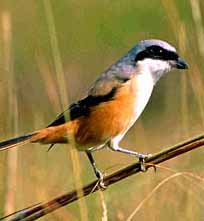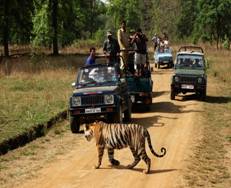INTRODUCTION
Bandhavgarh National Park spreading over an area of about 437 sq. kilometer is one of the wild life sanctuaries in the Indian state, Madhya Pradesh. Bandhavgarh National Park derives its name from an ancient fort in the area. This park is mostly of wetland plateau and is the home to timid animals to the most ferocious tigers. Bandhavgarh National Park belonging to the Vindhyan mountain ranges has notable features of tropical forests and woodlands, and steep rocky hills with flat grasslands in the valleys below. This park is supposed to have the highest density of tiger population in the country, which attracts lot of tourist crowd from all over the world.
HISTORY
Bandhavgarh which got its status of a park in the year 1968 was initially a hunting ground of the royal family of Rewa.During its early stages it occupied only an area of about 106 sq-km but now after it was taken over by the government and of a recent study it shows that the park spreads over an area of about 448 sq-km.These areas consisted primarily of Sal forests, which is the main tree-areas found in the entire park along with Bamboo. In the year 1993, the Bandhavgarh National Park was finally declared a reserve under Project Tiger.
ORIENTATION
Bandhavgarh National Park is situated in Shahdol district among the outlying hills of the Vindhya range. Latitudes and longitudes are 23�30' to 23�46' North and 80�11' to 80�36'East.
BEST TIME TO VISIT
The ideal time to visit the Bandhavgarh National Park is between the Mid-novembers to June. The park remains closed during the monsoon months from July to early November.
PLACES OF INTERESTS
Bandhavgarh Fort
 |
The Bandhavgarh Fort is nearly 2,000 years old and there are no references of when and by whom it was constructed. However there are references about it in the ancient books like the Narad-Panch Ratra and the Siva Purana.
It is believed that Bandhavgarh Fort was ruled by the Maghas from the 1st century AD, the Vakatakas from the 3rd century; the Sengars from the 5th century and the Kalchuris from the 10th century followed by the Baghels till 1617. The last inhabitants deserted the fort in 1935.
The Flora
 |
Being classified as moist deciduous, the Bandhavgarh National Park is noted for its excellent tree and foliage concentration with animal species pertaining to such habitat. Areas towards the south and the west are drier in character, and hold such species as the Nilgai and the Chinkara.
Stretches of bamboo and grasslands extend to the north. Apart from the Sal throughout the valleys, you can also see a mixed forest of sali, saj, saja, dhobin etc. in the higher lands. Grassy meadow patches occur in the valley and along the nalas.
The Fauna
 |
The Bandhavgarh National Park is rich in fauna especially the big cat population.Sambar and Barking Deer are a common sight, and Nilgai are to be seen in the more open areas of the park. Apart from the tiger, the wildlife here lists the leopards, gaur, chital (spotted deer), Sambar deer, Dholes, nilgais, wild boars, chinkaras, sloth bears, rhesus macaques, chital, black faced langurs, jungle cats, hyenas, porcupines, jackals, foxes, wild dogs, chausinghas and ratels, among others.
The Avi-fauna
 |
The Bandhavgarh National Park is not only famous for wild animals but also for birds. The most common sight of birds here includes white browed fantails, steppe eagles, green pigeons, white rumped shama, grey malabar hornbills, black and white malabar hornbills (quite a rare sighting), blossom headed parakeets, parakeets, blue bearded bee eaters, green bee eaters, white bellied drongos, owls, Jerdon's and gold fronted leaf birds, minivets, woodshrikes and the lovely paradise flycatchers. The other common ones are Little Grebe, Egret, lesser Adjutant, Sarus Crane, Black Ibis, Lesser Whistling Teal, White-eyed Buzzard, Black Kite, Crested Serpent Eagle, Black Vulture, Egyptian Vulture, Common Peafowl, Red Jungle Fowl, Dove, Kingfishers and Indian Rollers. Reptilian Fauna include Cobra, Krait, Viper, Rat-snake, Python, Turtle and a number of lizard varieties, including Varanus.
Things to do
Elephant Safari
 |
The Safari especially on the elephant back is the most thrilling part of the tour into the Bandhavgarh National Park. The experience of sitting high a top an elephant in a teak wood chair is quite cool and is one of the most famous ways to track the tigers.
Jeep safaris are undertaken during the early morning hours till evening. A forest department guide is always their with the visitors on these jeep trips taken inside the park. There is a fixed entry and exit time into the forest.
Eat outs
Though there are no major hotels in this area almost all the resorts here have attached restaurants to it serving decent Indian and continental food. Some of the few resorts with built in restaurants are
|
1. Tiger Trail Resort ACCOMMODATION1.TIGER TRAILS RESORT 2.Tiger's Den Resort
3.Mogli Jungle Resort |
Travel Guide
Travel Information
| |||||||||||||||||||||||||||||||||||||||
HOW TO REACH
By Air
Khajurao at 230 km is the most convenient airport connected to the park by various domestic airline services with Agra, Delhi, Varanasi.
By Trains
The nearest railhead Umaria at 30 km is on the Katni-Bilaspur section of South-Eastern Railway. Another convenient railhead Satna (117 km) is on the Bombay-Howrah main line of the Central Railway.
By Road
Bandhavgarh National Park is situated on the Satna-Umaria & Rewa-Umaria highway. Madhya Pradesh State Transport Bus Services are also available from Rewa, Satna, Katni and Umaria.




